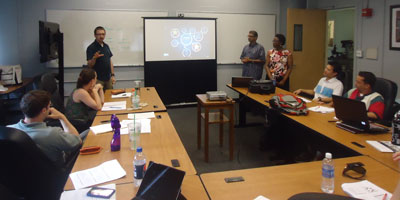Science and Mechatronics Aided Research for Teachers with an Entrepreneurship Experience (SMARTER)
2013: Week II
Linda Dombi
Today is the start of week two in the 2013 SMARTER project. We continued with structured training involving lectures and labs. Today's morning lecture introduced the highly versatile and popular 555 Timer chip to us. We learned how the 555 Timer operates and some of the applications for this stable and extensively used integrated circuit chip. The afternoon lecture focused on infrared (IR) emitters and detectors. We learned the functions of and uses for the IR LED and the IR detector. Back in the lab, we used the 555 Timer to generate frequencies in the audible range. We programmed our Basic Stamp 2 microcontrollers to monitor and process the frequency data.
We also worked with our BOE-Bot robots. Specifically, we programmed our BOE-Bots to navigate based on different types of sensory inputs. First we installed "whiskers" on the BOE-Bot and programmed the BASIC Stamp to check signals from the whiskers between each servo pulse. This allowed our BOE-Bot to avoid objects in its path. Next, we added the IR LED and detectors to the BOE Bot to shine IR into the BOE-Bot's path and look for its reflection. This method allowed the BOE-Bot to detect an object without physically contacting the object. We ended the day working on a program to make our BOE-Bot, instrumented with photo-resistive sensors, follow a winding, curving line of black electrical tape.
In my opinion, this is our most challenging lab thus far. Good luck to everyone.

Tim Dennis
Today morning we learned about integrated circuits which convert analog signals to digital signals, this is helpful since many physical phenomena give rise to analog signals which must be processed by computing devices that are digital.
In one activity, we used the converted signal to determine the potential difference across a rotary potentiometer which in turn can be used to determine angular position of a robot arm connected to the potentiometer. In the afternoon we learned about temperature sensors. We finished the day by experimenting with the various components at our disposal.
Today, four alumni from prior cycles of the RET project at NYU Tandon visited and spoke to us. They shared their experiences on using their learning and knowledge gained from the project in their schools and classrooms.

Kelly Brandon
Today we learned about filters and op amps, use of differential equations to model electrical circuits, and use of transfer functions to formulate input-output models for electrical circuits. We also learned about how to connect our new knowledge (of filters, op-amps, signals, noise, etc.) with real-world applications in music, radio, noise/disturbance filtering, etc.
Finally, we learned about ultrasonic sensors and its use in distance measurement. Once back in the lab, various teams continued to work with their Boe-Bots to improve algorithms for the robots to follow solid black lines (see enclosed video), detect objects with an ultrasonic distance sensor, and follow other robots (see enclosed video). Our group started by using infrared LEDs and infrared detectors for a "follower" Bot to sense a "leader" Bot in front of it. Through experimentation, we concluded that we could obtain more reliable results by using the ultrasonic distance sensor versus the infrared detector for determining actual distances of objects from the robot. So we improved our follower Bot by adding an ultrasonic distance sensor to its front.
We are now working on blending the use of the infrared detector for peripheral vision (to control the left and right correcting turns of the Bot) with the use of the ultrasonic distance sensor to control the speed of the Bot, depending on the distance from the follower Bot to the leader Bot.
Dwight Young
Today we started a two day session focused on an Introduction to Entrepreneurship. Entrepreneurship, as our instructor Prof. Nov explained, is the practice of accepting the risk of starting and running a business. There are pros and cons involved when venturing into entrepreneurship. Some advantages of being an entrepreneur include more control, flexibility, and a salary that is based on achievement with significant potential to grow. Alternatively, disadvantages of being an entrepreneur include uncertainty work schedules, salary and administrative issues, and competition from rival companies. Necessarily, entrepreneurs must be self-sufficient, self-directed, extremely motivated, and be able to make informed judgments.
At the heart of entrepreneurship is the foundation of the entrepreneur’s ideas, detailed in a business plan. This document describes the purpose of the intended business, its goals, client base, organization, marketing strategies, and financial projections. Professor Nov stressed that during the process of formulating a business plan an entrepreneur must carefully handle several competing forces at work. Known as Porter’s five forces, they include the degree of existing rivalry, the threat of potential entrants, the bargaining influence of suppliers and buyers, and the effect of substitutes and complements on the success of the business.
Also noteworthy is the importance of realizing that many well established corporations have flourished on the founding ideas of other individuals, those who are known as first movers. While first movers may be unsuccessful to a certain extent in growth of their business, followers can build upon their ideas and make the necessary adjustments to create a vision for a business that may far exceed the national and international influence of its predecessor.
Lastly, this entrepreneurship module pointed out that timing is key in the development of a business. Customer needs, availability of complementary products and/or services, the presence of competitive threats to the product, and ability to withstand early losses and just some of the fundamentals factors that must be considered when determining the best time to venture into business.
Jason Econome
In the morning session, we learned several core concepts of entrepreneurship, for example, how to develop a business plan for a new product or service. In the afternoon, we worked in teams of three each to consider creation of a product and its corresponding business plan. Each team of teachers ended the day by pitching their idea to the rest of the teachers. Our team (Dwight, Peter, and I) enjoyed exchanging new product ideas and finally agreed on an eco-friendly product “ceiling greens”, a micro-controlled, self-sustaining, garden systems for inside the home. Our business plan included an executive summary, goals for our product, and a description of how the product works. We performed a market analysis to identify potential customers and competitors. Finally, we also developed sales and cost projections to help decide if our would be profitable and of interest to potential investors and other stakeholders.
Jason Econome
It was a great deal of fun visiting NYU Tandon’s technology business incubator in Manhattan this morning. We learned about the purpose of an incubator from its manager, Samir. He went into great detail the number of ways they can help the “start-up” company and the expectations that are placed on these hopeful entrepreneurs. We were then visited by representatives from two start-up companies. One presenter discussed a new means to charge electricity-driven delivery trucks (and other large vehicles). The other presenter discussed a software product that helps teachers communicate to parents their child's absentee issues. We returned to the NYU Tandon in the afternoon to discuss the many ways or types of investors available to the entrepreneur to produce and market a product or service. We then met in teams to discuss how to acquire the necessary capital to bring new ideas to market.
Charisse A. Nelson
Today, after learning about the extensive resources available via NYU Tandon's business incubators, we continued our journey of connecting technology with entrepreneurship by learning how to raise funds. Many, though not all, of the start ups at the NYU Tandon incubators are companies, which means they have already started this very important process.
It is recommended that the process of raising funds start with family and friends as future investors will be interested not only in how much of your own money you were willing to risk, but also if you were able to convince family and friends to risk their money for your great idea. Next, funds can be sought from bank/finance companies, government agencies, such as the Small Business Administration, and crowdfunding sources such as Kickstarter and Lending Club.
In addition, you can look to various types of angel investors, who typically invest their own funds, or venture capitalists, who typically invest the pooled funds of others, such as pension fund monies. They do this in exchange for partial ownership. Once you have raised enough capital to get your business up and running successfully the chain then moves to how you plan to maintain/grow it. Two options are going public, which means the public becomes your partner, or getting acquired by a larger company.
All the ways of raising and maintaining funds come with pros and cons, which should be weighed as you make the tough decisions needed to make and keep your business a success.
